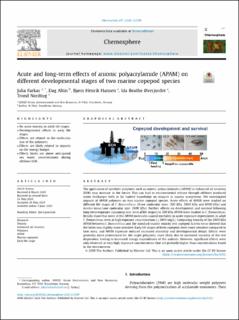| dc.contributor.author | Farkas, Julia | |
| dc.contributor.author | Altin, Dag | |
| dc.contributor.author | Hansen, Bjørn Henrik | |
| dc.contributor.author | Øverjordet, Ida Beathe | |
| dc.contributor.author | Nordtug, Trond | |
| dc.date.accessioned | 2020-11-16T11:09:53Z | |
| dc.date.available | 2020-11-16T11:09:53Z | |
| dc.date.created | 2020-11-09T17:58:37Z | |
| dc.date.issued | 2020-10 | |
| dc.identifier.issn | 0045-6535 | |
| dc.identifier.uri | https://hdl.handle.net/11250/2688000 | |
| dc.description.abstract | The application of synthetic polymers such as anionic polyacrylamides (APAM) in enhanced oil recovery (EOR) may increase in the future. This can lead to environmental release through offshore produced water discharges with so far limited knowledge on impacts in marine ecosystems. We investigated impacts of APAM polymers on two marine copepod species. Acute effects of APAM were studied on different life stages of C. finmarchicus (three molecular sizes: 200 kDa, 2800 kDa and 8000 kDa) and Acartia tonsa (one molecular size: 2800 kDa). Further, effects on development and survival following long-term exposure (spanning over several life stages) to 200 kDa APAM were studied in C. finmarchicus. Results show that none of the APAM molecules caused mortality in acute exposure experiments in adult C. finmarchicus even at high exposure concentrations (≥1000 mg/L). Comparing toxicity of the 2800 kDa APAM between C. finmarchicus and the standard marine toxicity test copepod Acartia tonsa showed that the latter was slightly more sensitive. Early life stages of both copepods were more sensitive compared to later ones, and APAM exposure induced increased mortality and developmental delays. Effects were generally more pronounced for the larger polymers, most likely due to increased viscosity of the test dispersions leading to increased energy expenditures of the animals. However, significant effects were only observed at very high exposure concentrations that are probably higher than concentrations found in the environment. | en_US |
| dc.language.iso | eng | en_US |
| dc.publisher | Elsevier Ltd | en_US |
| dc.rights | Navngivelse 4.0 Internasjonal | * |
| dc.rights.uri | http://creativecommons.org/licenses/by/4.0/deed.no | * |
| dc.subject | Toxicity | en_US |
| dc.subject | Enhanced oil recovery | en_US |
| dc.subject | Polymers | en_US |
| dc.subject | APAM | en_US |
| dc.subject | Marine copepods | en_US |
| dc.subject | Early life stage | en_US |
| dc.title | Acute and long-term effects of anionic polyacrylamide (APAM) on different developmental stages of two marine copepod species | en_US |
| dc.type | Journal article | en_US |
| dc.type | Peer reviewed | en_US |
| dc.description.version | publishedVersion | en_US |
| dc.rights.holder | ©2020 The Authors. Published by Elsevier Ltd. This is an open access article under the CC BY license (http://creativecommons.org/licenses/by/4.0/).Chemosphere 257 (2020) | en_US |
| dc.source.volume | 257 | en_US |
| dc.source.journal | Chemosphere | en_US |
| dc.identifier.doi | https://doi.org/10.1016/j.chemosphere.2020.127259 | |
| dc.identifier.cristin | 1846330 | |
| cristin.ispublished | true | |
| cristin.fulltext | original | |
| cristin.qualitycode | 1 | |

